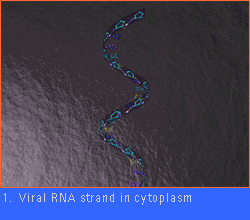
|
 |
 |
Viral Entry | Viral Gene Transfer | Viral Exit
This sequence depicts viral RNA transforming itself into double-stranded DNA, then integrating into the host cell's DNA in order to produce new viral RNA. Once inside the host cell, the viral RNA migrates toward the nucleus through the cell's cytoplasm and eventually through the nuclear membrane. A series of steps that ultimately ends in a new HIV particle follows. First, through a process known as reverse transcription, the enzyme known as reverse transcriptase catalyzes the formation of double-stranded viral DNA using the single-stranded viral RNA as a template. Employing other enzymes such as integrase (shown by the starburst in step 4 and in the graphic at right above), the new viral DNA then breaks open the host cell's DNA and integrates itself into it. This leads to the formation of a new viral RNA strand, which migrates out of the host's DNA. The new viral RNA moves into the cytoplasm, where new viral proteins are built using the viral RNA as a blueprint. Viral Entry | Viral Gene Transfer | Viral Exit Search for a Vaccine | See HIV in Action | AIDS in Perspective The Virus Fighters | Fighting Back | Help/Resources Teacher's Guide | Transcript | Site Map | Surviving AIDS Home Editor's Picks | Previous Sites | Join Us/E-mail | TV/Web Schedule About NOVA | Teachers | Site Map | Shop | Jobs | Search | To print PBS Online | NOVA Online | WGBH © | Updated October 2000 |

